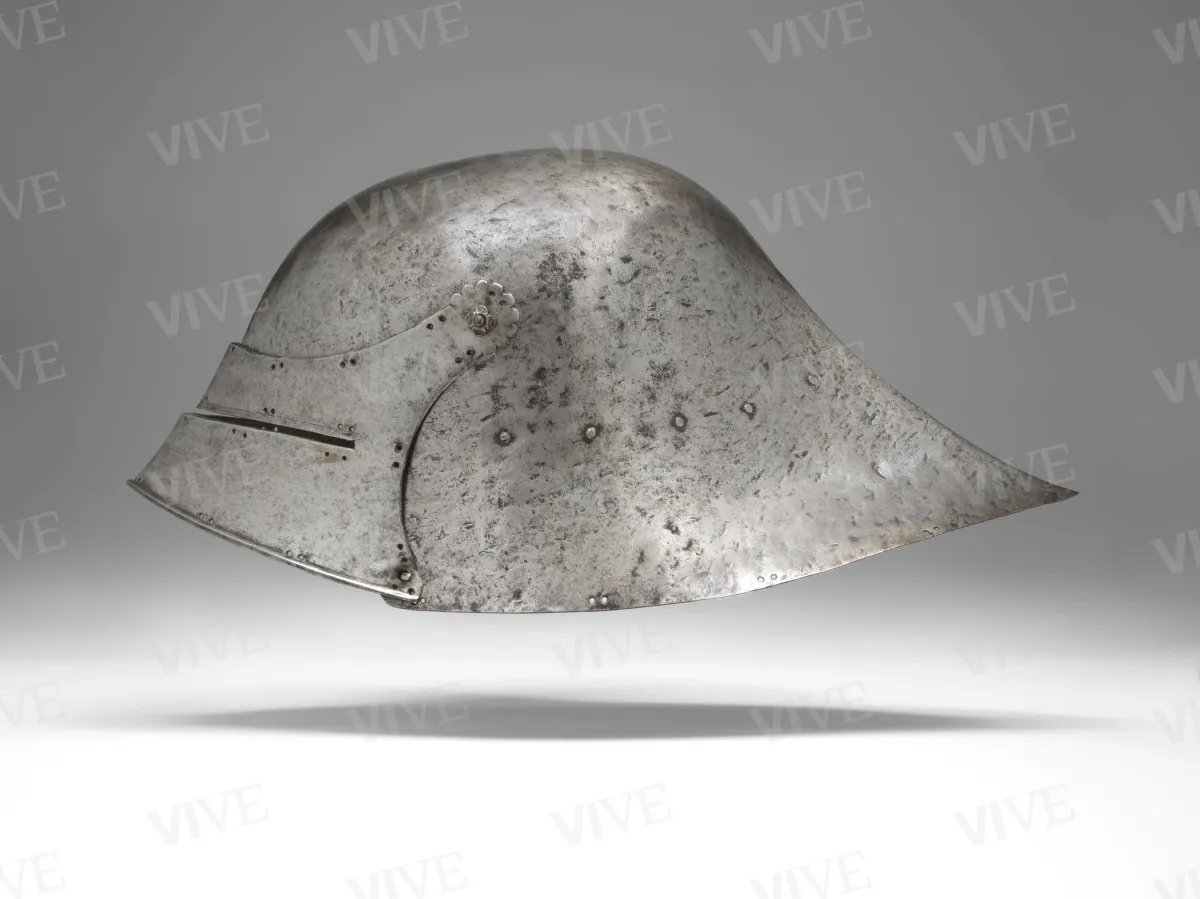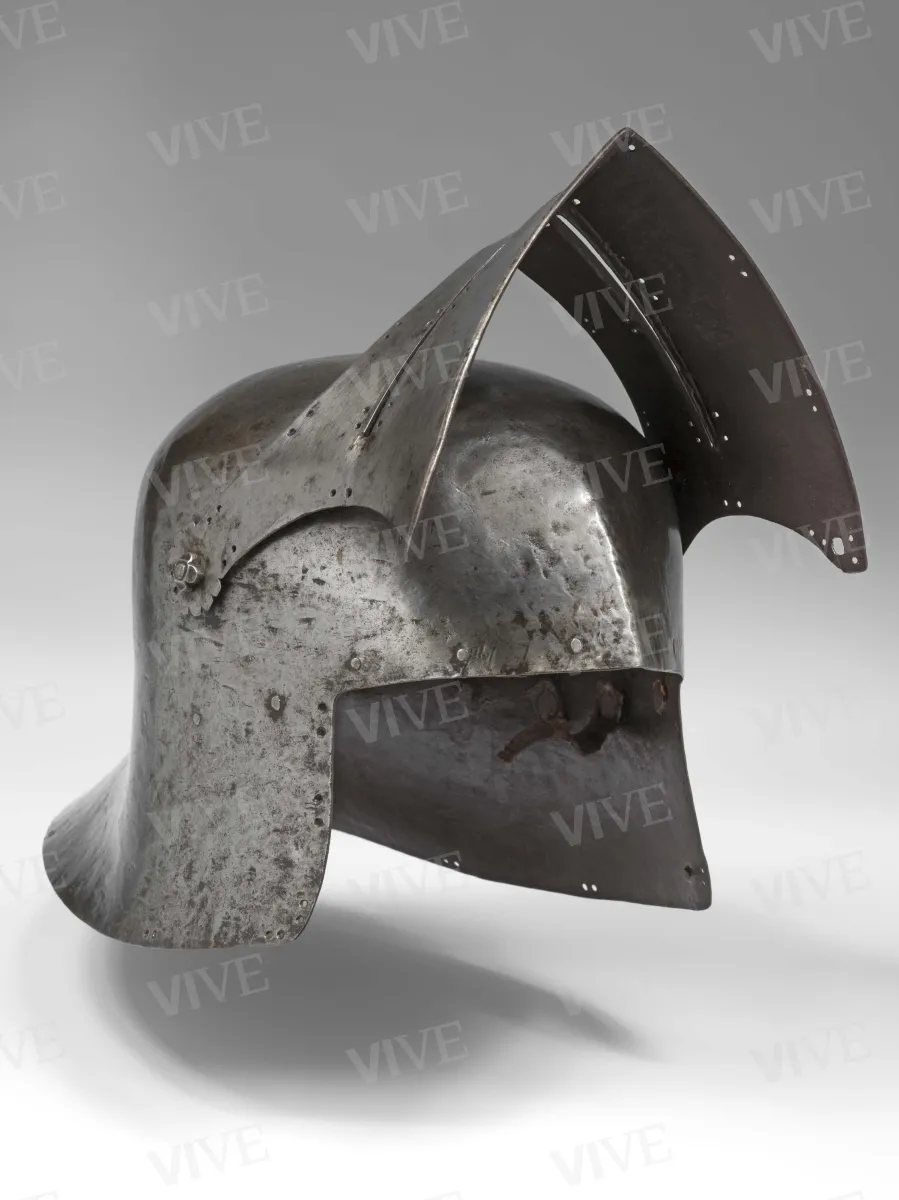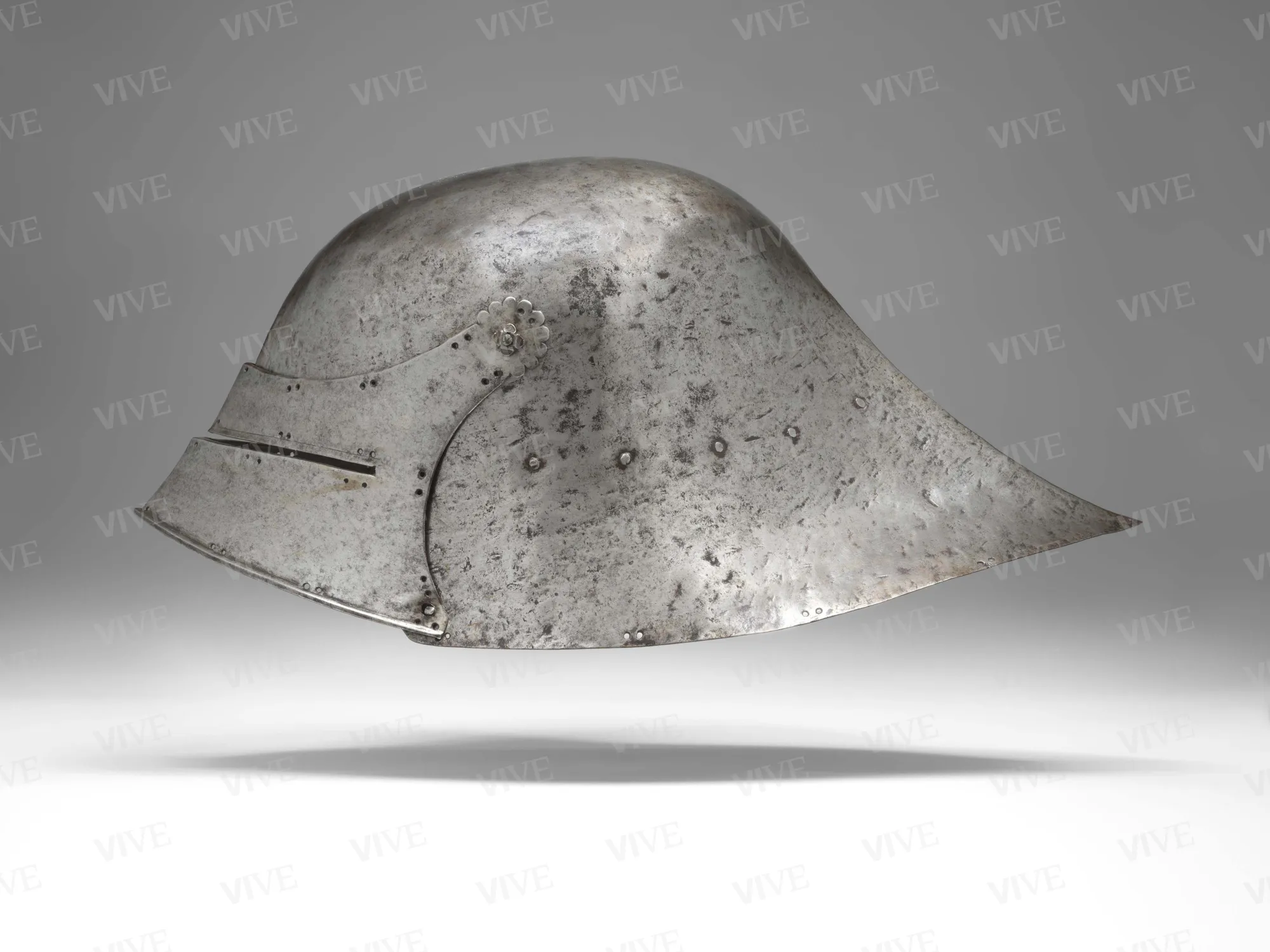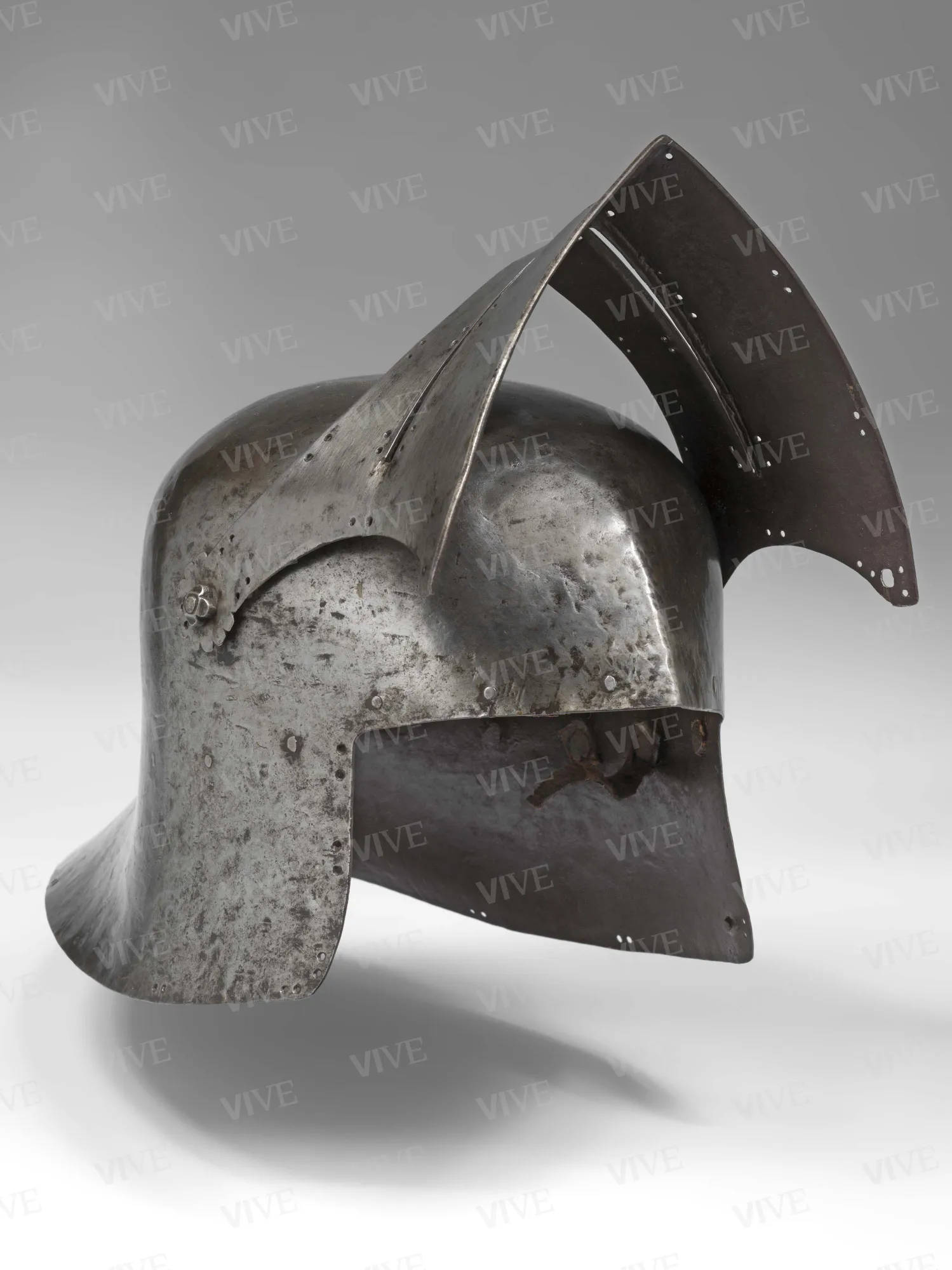Fan-shaped sallet
Austrian production 1490–1500
The sallet, a war helmet employed during the fifteenth century, served to safeguard soldiers’ heads. This particular specimen, crafted in Austria, exhibits a straightforward design. It comprises two components: the skull, featuring an elongated point to shield the nape of the neck, and the fan or visor, which could be elevated for practicality or lowered during combat, providing a narrow slit for visibility.
The sallet, a war helmet employed during the fifteenth century, served to safeguard soldiers’ heads. This particular specimen, crafted in Austria, exhibits a straightforward design. It comprises two components: the skull, featuring an elongated point to shield the nape of the neck, and the fan or visor, which could be elevated for practicality or lowered during combat, providing a narrow slit for visibility.
Details of work
Catalog entry
The sallet comprises an elongated skull, devoid of a crest, characterized by arched lower edges, often referred to as "boat-shaped." It features a hinged visor secured by a poly-lobed rivet that locks into a flower-shaped knuckle protuberance. Below the shell, smooth rivets are positioned to fasten the internal padding. This helmet retains its original lining and fastening ties (di Carpegna 1969, p. 9, n. 32). The fan associated with this sallet has been debated; some deem it not in keeping (di Carpegna 1969), while others argue it is characteristic of such helmets, noting that the imperfect alignment between the fan's edge and the coppo's lower edge results from these headdresses traditionally being covered with leather. This leather covering, secured by ties through pairs of holes along the perimeter, was then painted for troop identification in battle (Müller 2002; Scalini 2018, p. 275, n. X.2).
The sallet is a type of war helmet that was commonly used across Europe during the fifteenth century, particularly in Germanic regions, as evidenced by numerous armaments depicted in Albrecht Dürer’s engravings. Initially made in the early fifteenth century in simple and functional designs, they attained a high level of aesthetic refinement by the mid-16th century, when notable artists began to craft them (Phyrr 2000). Unlike other types of helmets, which were heavier and bulkier, the sallet lacked both a high crest and a crest (or cimiero), featuring only a straightforward visor that could easily be raised when needed. This design evolved from a type made from a single piece (inv. 12050; Gelli 1900, pp. 81–91; Oakeshott 2012, pp. 109–116).
Additional examples of this "boat" type, ascribed to Austrian weapon makers or workshops in southern Germany, are also conserved at the Wallace Collection in London (inv. A81; Mann 1962) and at the Philadelphia Museum of Art. The latter features an item nearly identical to the one discussed here, originating from the collection of Carl Otto von Kienbusch (inv. 1977-167-73). Kienbusch, a friend of and competitor in acquisitions for Prince Ladislao Odescalchi (1846–1922), formerly owned this piece. The collection was acquired by the Italian State in 1959 and allocated to Palazzo Venezia in 1969. It is not a family armory but rather a curated selection of items purchased from national (Florence, Rome) and international (Paris, London) markets in the late nineteenth century, reflecting Odescalchi's personal preferences (Barberini 2007).
Giulia Zaccariotto
Entry published on 27 March 2025
State of conservation
Good.
Provenance
Rome, Collezione Ladislao Odescalchi (Odescalchi, no. 764);
purchased by the Italian State, 1959;
Rome, Museo Nazionale di Palazzo Venezia, 1969.
Exhibition history
Rome, Museo Nazionale di Palazzo Venezia, Antiche armi dal sec. IX al XVIII. Già Collezione Odescalchi, May–July 1969;
Rome, Museo Nazionale di Castel Sant’Angelo; Rome, Museo Nazionale di Palazzo Venezia, Armi e potere nell’Europa del Rinascimento, July 26–November 11, 2018.
References
Gelli Jacopo, Guida del raccoglitore e dell’amatore di armi antiche, Milano 1900;
Mann James Gow, Wallace Collection. European arms and armour, London 1962;
di Carpegna Nolfo (a cura di), Antiche armi dal sec. IX al XVIII. Già Collezione Odescalchi, catalogo della mostra (Roma, Museo Nazionale di Palazzo Venezia, maggio-luglio 1969), con schede a firma del curatore, Roma 1969, p. 9, n. 32;
di Carpegna Nolfo, Le armi Odescalchi, Roma 1976;
Pyhrr Stuart W., S.J. Whawell and the Art Market, in The Eleventh Park Lane Arms Fair, London 1994, pp. 14-23;
Pyhrr Stuart W., European Helmets, 1450-1650. Treasures from the Reserve Collection, New York 2000;
Müller Heinrich, Albrecht Dürer Waffen und Rüstungen, Mainz am Rhein 2002;
Barberini Maria Giulia, La collezione Odescalchi di armi antiche: storia della raccolta del principe Ladislao, in «Bollettino d’arte», s. VI, XCI, 2006 (2007), 137/138, pp. 101-114;
Fossà Bianca, Studio conservativo delle armi e armature Odescalchi. Nuove metodologie per la schedatura di una collezione, in «Bollettino d’arte», s. VI, XCI, 2006 (2007), 137/138, pp. 115-142;
Oakeshott Ewart, European Weapons and Armour. From the Renaissance to the Industrial Revolution, Woodbridge 2012 (I ed. 1980);
Pyhrr Stuart W., Of Arms and Men. Arms and Armor at the Metropolitan 1912-2012, New York 2012;
Scalini Mario (a cura di), Armi e potere nell’Europa del Rinascimento, catalogo della mostra (Roma, Museo Nazionale di Castel Sant’Angelo; Roma, Museo Nazionale di Palazzo Venezia, 26 luglio-11 novembre 2018), con schede a firma del curatore, Cinisello Balsamo 2018, p. 275, n. X.2.














